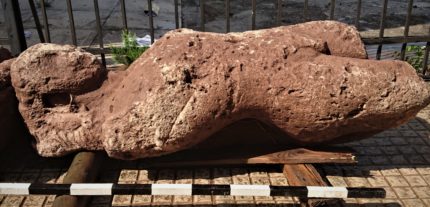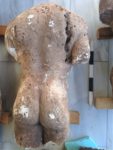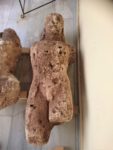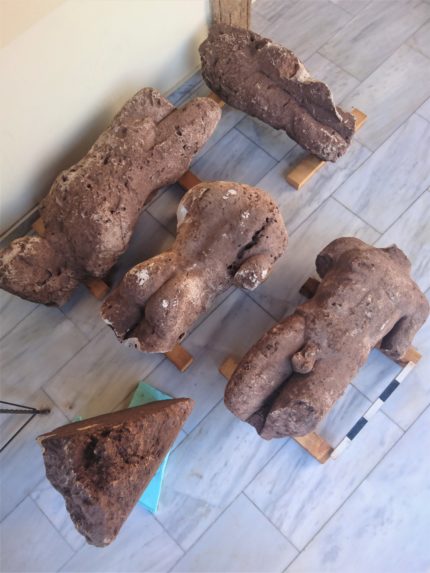
 Archaeologists have discovered four Archaic era kouros statues in Atalanti, central Greece. The first of the sculptures was discovered by the property owner when he was plowing a field. He unearthed the limestone torso of a nude male youth 2’9″ high and immediately alerted the regional archaeological authority to his find. The kouros was recovered and transferred to the Archaeological Museum of Atalanti.
Archaeologists have discovered four Archaic era kouros statues in Atalanti, central Greece. The first of the sculptures was discovered by the property owner when he was plowing a field. He unearthed the limestone torso of a nude male youth 2’9″ high and immediately alerted the regional archaeological authority to his find. The kouros was recovered and transferred to the Archaeological Museum of Atalanti.
The Ephorate of Antiquities of Fthiotida and Evritania dispatched an archaeological team to conduct a thorough field excavation of the find site and environs. They have been  digging there since mid-October and have found another three life-sized kouroi. In a test trench on the north section of the site, the team found a limestone kouros four feet high. It is intact from head to the thighs and depicts a bearded man with his left leg forward. Next to it was the lower torso of a male 2’8″ long extending from the lower back to the tibia. The plinth that runs along the back surface is intact. The third kouros was found last Friday (November 2nd). It is 3’1″ from throat to thighs and the left leg is extended. A trihedral block found right next to it is likely a fragment of the base of the third statue.
digging there since mid-October and have found another three life-sized kouroi. In a test trench on the north section of the site, the team found a limestone kouros four feet high. It is intact from head to the thighs and depicts a bearded man with his left leg forward. Next to it was the lower torso of a male 2’8″ long extending from the lower back to the tibia. The plinth that runs along the back surface is intact. The third kouros was found last Friday (November 2nd). It is 3’1″ from throat to thighs and the left leg is extended. A trihedral block found right next to it is likely a fragment of the base of the third statue.
 It’s a remarkable haul for such a short excavation of a small portion of a field which has seen such recent agricultural activity, but the Archaic sculptures aren’t the only archaeologically significant remains discovered at the site. In deeper layers than the ones where the kouroi were located, archaeologists unearthed seven graves dating from the 5th century B.C. through the second. The grave goods are reportedly impressive although no details are forthcoming yet. This was not a random group of burials. Their arrangement and location near the modern city Atalanti indicates they were part of an organized cemetery of the ancient Mycenaean city of Opus, founded in the Late Helladic period (1600–1100 B.C.) and well-populated until the Gothic invasions of the 4th century.
It’s a remarkable haul for such a short excavation of a small portion of a field which has seen such recent agricultural activity, but the Archaic sculptures aren’t the only archaeologically significant remains discovered at the site. In deeper layers than the ones where the kouroi were located, archaeologists unearthed seven graves dating from the 5th century B.C. through the second. The grave goods are reportedly impressive although no details are forthcoming yet. This was not a random group of burials. Their arrangement and location near the modern city Atalanti indicates they were part of an organized cemetery of the ancient Mycenaean city of Opus, founded in the Late Helladic period (1600–1100 B.C.) and well-populated until the Gothic invasions of the 4th century.

So I assume these figures formed some kind of grave markers?
Is the soil highly acidic? They look like they are half-dissolved. Still, huge find!
The counterpart to those naked ‘kouroi’ are -not so naked- ‘ko(u)rai’.
Indeed, these ‘kouroi’ could have been grave markers, but the graves underneath could also be coincidence – cf. the ‘Porch of the Caryatids’ in Athens.
There were a couple of real earthquakes, as well as a couple of ‘cultural’ ones: It would be great to know more about the graves, and if there is some kind of structure the ‘kouroi’ could have been mounted on.
However, to me those ‘kouroi’ seem to be archaic and older than the seven graves underneath, i.e. the ones that date ‘from the 5th century B.C. through the second’.
If that is the case, it would at least indicate that the ‘kouroi’ where indeed brought from elsewhere and just deposited. …Maybe ‘re-used’ 😀
Soil can do its part, but that’s modern farming..Industrial Fertilizers dissolve anything that plowing does not destroy!